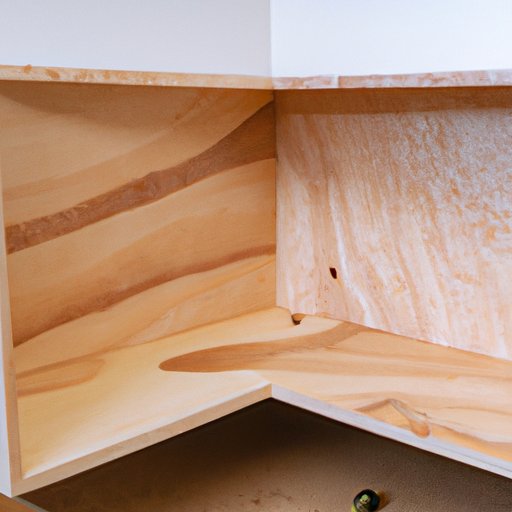
Introduction
Are you looking to upgrade your kitchen countertops without breaking the bank? Look no further than butcher block countertops! Not only are they affordable, they also add warmth and character to any kitchen. Plus, installing them yourself is easier than you might think. In this article, we’ll provide a step-by-step guide so you can install your own butcher block countertops, as well as cover different design ideas, materials, and tools to help you make the best choice for your kitchen.
Step-by-Step Guide
Installing butcher block countertops is a relatively simple process that most DIYers can tackle with the right tools and preparation. Here’s a basic guide to get you started:
1. Measure and cut your butcher block slab to size. Once you’ve determined the size of your countertops, measure your butcher block slab and then use a saw to cut it down to size. Be sure to account for any overhang you may want on your countertop.
2. Sand the countertop. Use sandpaper to smooth out any rough edges or surfaces on the butcher block, starting with a coarse grit and then gradually increasing the grit until the surface is smooth to the touch.
3. Test the fit. Place the butcher block countertop onto the cabinet to test the fit and make any necessary adjustments. You may need to cut a hole for a sink if you plan to install one.
4. Attach the countertop to cabinets. Once the fit is right, apply a bead of silicone to the top edges of the cabinet and then carefully place the countertop onto the silicone. Use screws to attach the countertop securely to the cabinets.
5. Seal the countertop. Choose a butcher block countertop sealant, and apply it evenly to the surface of the countertop. Follow the manufacturer’s instructions for drying and curing time.
Pros and Cons
There are many reasons to choose butcher block countertops for your kitchen, but they’re not without their downsides. Here are some pros and cons to help you weigh your options:
Pros:
– Affordable
– Warm, natural look
– Durable
– Easy to clean and maintain
– Reversible
Cons:
– Susceptible to scratches and dents
– Can be sensitive to moisture and fluctuating temperatures
– Require regular oiling and sealing
– Potential for harboring bacteria
Tools and Materials
Before you begin installing your butcher block countertops, make sure you have the proper tools and materials on hand:
– Measuring tape
– Saw
– Drill
– Screws
– Sandpaper
– Silicone caulk
– Butcher block sealant
While you can purchase butcher block countertops at most home improvement stores, you may also want to consider buying them from specialty vendors who offer a wider range of wood types.
Troubleshooting
Like any DIY project, installing butcher block countertops can sometimes come with its own set of challenges. Here are some common problems that may arise, as well as tips for avoiding them:
– Gaps between the countertop and cabinets: Before you attach the countertop, make sure the edges of the cabinets are straight and even. If there are still gaps, apply extra silicone caulk to fill them in.
– Warping: Butcher block is sensitive to moisture, which can cause warping. To avoid this, seal and oil the countertop regularly.
– Scratches and dents: Use a cutting board for food prep and avoid placing hot dishes directly on the countertop. If scratches or dents do appear, sand them down and reapply sealant.
DIY vs. Professional Installation
While installing butcher block countertops yourself can save you money, it may not be the best choice for every budget or skill level. Hiring a professional can provide peace of mind and ensure a smooth installation. Here are some factors to consider when deciding which route to take:
– Cost of materials
– Time available to complete the project
– Skill level and familiarity with tools
– Desired level of customization
Design Ideas
Butcher block countertops offer a versatile and charming look that can pair well with a variety of kitchen styles. Here are some design ideas to inspire your own installation:
– Farmhouse: Pair a light-colored butcher block with white cabinets and a deep apron sink for a classic farmhouse look.
– Modern: Use a darker butcher block with sleek, dark cabinets and stainless steel appliances for a modern, industrial feel.
– Rustic: Choose a distressed or reclaimed wood slab for a rustic, cabin-inspired look.
– Classic: Stick with a traditional, polished butcher block for a simple and timeless kitchen design.
Conclusion
Butcher block countertops are a stylish and cost-effective way to update any kitchen. Whether you choose to install them yourself or hire a professional, by following our guide you’ll be able to enjoy your new countertops in no time. With proper maintenance and care, your butcher block will last for years to come.





